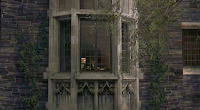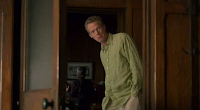Point 1:
Camera Angles/Shots/Movements:
- -Multiple close ups of his work as he writes and
draws
- -Close ups of his face to show his reaction and
to show him working
- -Close up of the pencil he is using and his hand.
Editing:
- -Cross cutting throughout this scene showing him
looking at his work
Sound:
- -Diegetic sound of him mumbling to himself
- - Non diegetic sound of increasingly loud music
which quickens its pace as he gets more into it.
Mise En Scene:
- -He is using a green pencil to work rather than a
normal pencil or pen, as green can connote illness it could be seen in the way
that he is mentally ill.
Point 2:
- -Camera slowly zooms out to show time passing
(also with use of editing)
- -Starts off with an establishing long shot of the
windows showing him in it
Editing:
 - -When the camera zooms out there is snow on the
windows, visual editing is used to make the snow melt and turn the season into
spring showing that he has worked a long time on this piece and giving the
impression that he hasn’t paused once.
- -When the camera zooms out there is snow on the
windows, visual editing is used to make the snow melt and turn the season into
spring showing that he has worked a long time on this piece and giving the
impression that he hasn’t paused once.
- -Time lapse of him working
Sound:
- -Music gets much louder as it zooms out and then
fades away when the time lapse has ended.
- -His mumbling gets quicker but slowly fades out
Mise En Scene:
- -Lighting of the scene gets brighter to show the
season changing, more orangey colours get introduced rather than the grey
colours of winter.
- -Shows him through a checked window, showing that
although he is making a discovery it’s clear something is wrong with him as he
isn’t taking a break at all
Point 3:
Camera Angles/Shots/Movements:
- - Camera is put on a crane in order to create the
sense that it is turning around to face the guy from the papers, it’s all done
in one shot.
- -Medium shot of Nash looking at the professor and
his imaginary friend anxiously.
- - Long shot of Nash’s imaginary friend waiting for
him in the corridor.
Editing:
 Use of graphic match from the papers that he was
working with to the same papers being held by the professor, showing the amount
of time that has passed and that the time has come to display his work/theory.
Use of graphic match from the papers that he was
working with to the same papers being held by the professor, showing the amount
of time that has passed and that the time has come to display his work/theory.
- - Cross cutting is used, showing Nash looking at
the guy anxiously
- -Eyeline match of Nash looking at the professor
and then his imaginary friend, shows us exactly what’s in his mind and makes it
clear that the professor isn’t bothered about the friend who is there, telling
us that it is likely he doesn’t exist.
Sound:
- -Non diegetic music fades and there is the
diegetic sound of his work rustling in the hands of the professor, brings us
back to reality and to
the present rather than us zapping through time (shows that a lot of time has passed)
the present rather than us zapping through time (shows that a lot of time has passed)
 - -No non diegetic music, only silence, showing the
tense situation. Can hear the diegetic noise of Nash breathing uneasily and
being unsettled in his chair.
- -No non diegetic music, only silence, showing the
tense situation. Can hear the diegetic noise of Nash breathing uneasily and
being unsettled in his chair.
Mise En Scene:
- - Dominant colour in the room is brown/orange, the
green of the pencil stands out among it.
- -The green colour of Nash’s imaginary friend
tells us that he is linked to his illness
Point 4:
Camera Angles/Shots/Movements:
 - -Utilises the same shots to contrast against the
previous section where Nash is worried about what the professor is going to
say, shows him as being rather happy with what he is saying, compares what he
was feeling.
- -Utilises the same shots to contrast against the
previous section where Nash is worried about what the professor is going to
say, shows him as being rather happy with what he is saying, compares what he
was feeling.
Editing:
- -Faster cutaways to the imaginary friend
celebrating to show that they
are happy, has cutaways to the professor and him
smiling.
- -Diegetic dialogue contrasts with the section
before when they weren’t talking and it was a tense scene
- -Hear the diegetic noise of Nash’s friend celebrating
in the corridor.
Mise En Scene:
 - -Nash’s imaginary friend’s movements contrasts
with the scene before as before he was standing and he wasn’t taking up much
room, however now he is dancing around the place showing that he is very happy
and making him take up more room.
- -Nash’s imaginary friend’s movements contrasts
with the scene before as before he was standing and he wasn’t taking up much
room, however now he is dancing around the place showing that he is very happy
and making him take up more room.
- -Nash is shown on as being on the side of the
frame, whereas the professor is in the centre. This shows that he is subject to
the professor and it gives the professor a lot of power over his life and what
happens next.





No comments:
Post a Comment